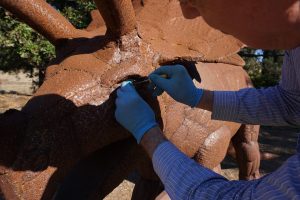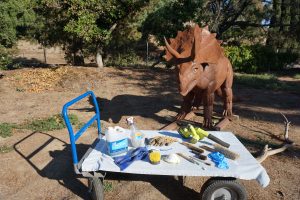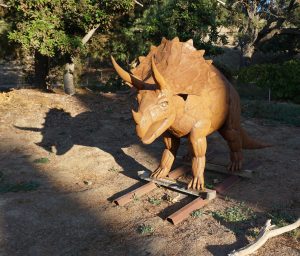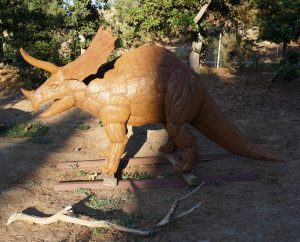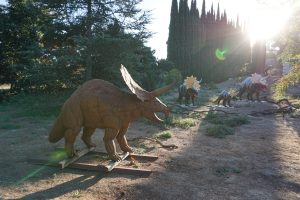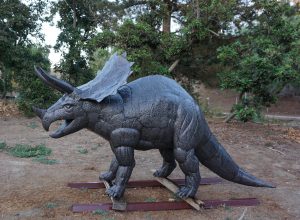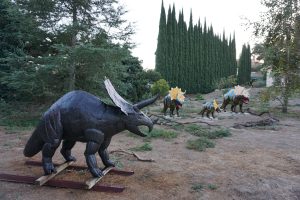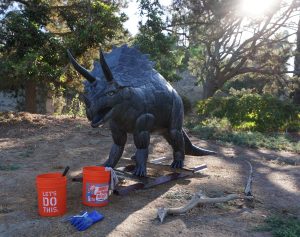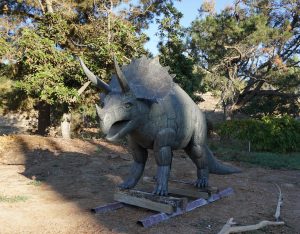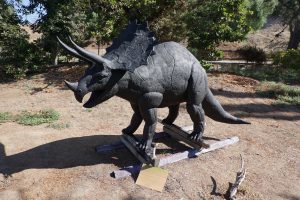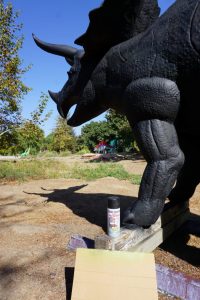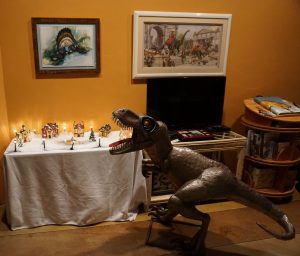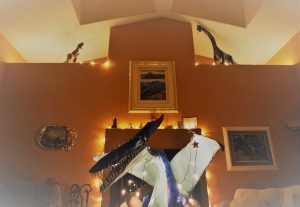Teresa is currently the largest Triceratop at the Park – 10 feet or so long and 6 feet high at the top of her shield. She has been very patiently waiting for some rust removal and splashes of color. Teresa will be getting a very different look than her Triceratop brothers – Paul, Marc & Christopher. First, I remove the plastic eyes to prevent damage from the wire brushing, acid wash and painting process. After clear coating they will be returned. A little screwdriver and some care and they’re out. The silicone glue that held them in place is removed from both the eyes and metal. Be careful when removing the silicone from the eyes not to damage the color underneath. The tools you will need for wire brushing and acid washing are displayed on the jumbo platform truck – gloves (leather & blue nitrile), wire brushes of various sizes, dusting brush, blower (helps keep the entire work area clean), acid wash, spray bottle, heavy duty rubber gloves, scrub brushes, mask – eye wear and hat are also good ideas.
Teresa being the “Big Girl” she is made it rather difficult to place on her side. Therefore, I opted to raise her platform high enough to reach into each foot at least a little. A vacuum and brushes helped in removing the unwanted spiders and loose rust. After completing the wire brushing, you may like this look and stop here. Although, I recommend a clear coat for protection before you stop. Check with your Home Improvement Store Specialist for a recommendation on the best product to use on the unpainted metal. On to the Acid Wash. I use the spray bottle and scrub brushes to apply the acid wash. The spray bottle is great for getting into those tight places a brush won’t reach. The Acid Wash should set over night.
The next morning buckets of water, heavy duty rubber gloves, brushes and towel assist in removing the excess acid material. After drying you may like this patina look and clear coat at this step. If not, on to the “Rust Reformer” step. The reformer seals any remaining rust it covers and provides a flat black base coat. Now this can be a scary look especially if you use accent paints for the mouth, horns, claws and eyes. If you decide to clear coat here, I would definitely use other colors for these key features first – the eyes at least.
Triceratops are from the Late Cretaceous Period. Triceratops are part of the family of Ceratopsoidea the group of Horned & Frilled Herbivore Quadruped Dinosaurs. Triceratops could reach 30 feet long at 8 tons! A Triceratops head was a third of its length. Image that horned head 10 feet long! A short horn at the end of its snout and two larger horns up to 3 feet long projecting from above each eye. All Triceratops fossils come from the Hell Creek Formation and other Cretaceous rock units in western North America (US & Canada). The first fossil found in 1887, a pair of brow horns, was mistaken for a prehistoric bison. From 100’s of early specimens discovered and described as 18 different species it was later determined these were various growth stages of one or two species. The horns and frills of the Triceratops dramatically change shape throughout its growth. Therefore Adults & Juveniles look very different.
Since then 80 species of Ceratopsians have been described, 55 of those since 2002! There have been more species of horned dinosaurs described in the last 10 years than the preceding 118 years.
References for information on the Triceratops provided by:
“Dinosaurs” by Steve Brusatte 2010
“Weird Dinosaurs” by John Pickrell 2016 (much more to come from this resource stay tuned)
“The Princeton Field Guide to Dinosaurs 2nd edition” by Gregory S. Paul 2016 contains a number of illustrations reflecting the various Ceratopsian Family skeletons many reflecting growth stage drawings.
Stay tune for more of Teresa – primer and color!
HAPPY HOLIDAYS
Below: Max helps with the Holiday Village. Back to Front Hobbes, Brandie & Antonio help with the star lights.
May the Wonder of Season be Yours!
“Encouraging the Appreciation of Art and Education through the Inspiration of Dinosaurs”
Paul & Prehistoric Pals
Your feedback is appreciated, Thank you!
